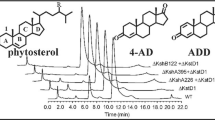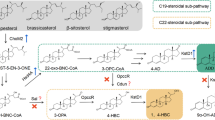Abstract
14α-hydroxy-androst-4-ene-3,17-dione (14α-OH-AD) is an important precursor for the synthesis of steroid drugs with anti-cancer and carcinolytic activity. Initially, 14α-OH-AD was mostly synthesized by whole-cell fermentation of mold fungi using androstenedione (AD) as a substrate, which had difficulties in product isolation and purification as well as problems of high production cost. In this study, the source of the 14α-hydroxylase gene was expanded. And 14α-hydroxylase genes were heterologously expressed in Mycolicibacterium neoaurum (MNR) M3ΔksdD, which enabled the one-step biotransformation from the cheap substrate phytosterols (PS) to 14α-OH-AD, reducing the difficulty of product purification and production cost. What is more, to alleviate the problem of poor activity of 14α-hydroxylase, the 14α-hydroxylase gene was co-expressed with the electron transport chain element genes and the coenzyme regeneration genes, and a superior engineered strain MNR M3ΔksdD/pMV261-14α-G6PDH was obtained. Finally, the transformation conditions were optimized for the transformation of PS by the engineered strain. The molar yield of 14α-OH-AD reached to 60.4 ± 2.3% (about 0.22 g/L productivity). This study investigated for the first time the effects of the tandem electron transport chain element genes and the tandem coenzyme regeneration genes on the 14α-hydroxylation reaction, providing a theoretical basis for the industrial production of 14α-OH-AD.








Similar content being viewed by others
Data availability
All data generated or analyzed during this study are included in this published article and its supplementary information files.
References
Fernandes P, Cruz A, Angelova B, Pinheiro HM, Cabral JMS. Microbial conversion of steroid compounds: recent developments. Enzyme Microb Technol. 2003;32(6):688–705. https://doi.org/10.1016/S0141-0229(03)00029-2.
Bhatti HN, Khera RA. Biological transformations of steroidal compounds: a review. Steroids. 2012;77(12):1267–90. https://doi.org/10.1016/j.steroids.2012.07.018.
Templeton JF, Sashi Kumar VP, Bose D, Smyth DD, Kim RS, Labella FS. Digitalis-like pregnanes cardiac and renal effects of a glycoside of 14 beta-hydroxyprogesterone. Can J Physiol Pharm. 1988;66(11):1420–4. https://doi.org/10.1139/y88-231.
Takara Y, Masaaki F, Yasuko F, Jo K, Masamichi N, Makoto Y, Hiroji O. Inhibitory effect of a new androstenedione derivative, 14α-hydroxy-4-androstene-3,6,17-trione (14α-OH-AT) on aromatase activity of human uterine tumors. J Steroid Biochem. 1990;36(6):517–21. https://doi.org/10.1016/0022-4731(90)90167-Q.
Parez V, Sutton D. Recent investigations of the efficacy and safety of proligestone for the prevention of oestrus and pseudopregnancy in bitches. J Reprod Fertil Suppl. 1993;47:544–5.
Karpova NV, Andryushina VA, Stytsenko TS, Druzhinina AV, Feofanova TD, Kurakov AV. A search for microscopic fungi with directed hydroxylase activity for the synthesis of steroid drugs. Appl Biochem Biotechnol. 2016;52(3):316–23. https://doi.org/10.1134/s000368381603008x.
Kollerov VV, Fokina VV, Sukhodolskaya GV, Shutov AA, Donova MV. 11β-hydroxylation of 6α-fluoro-16α-methyl-deoxy-corticosterone 21-acetate by filamentous fungi. Appl Biochem Microb. 2015;51(2):169–79. https://doi.org/10.1134/S0003683815020106.
Kolet SP, Haldar S, Niloferjahan S, Thulasiram HV. Mucor hiemalis mediated 14α-hydroxylation on steroids: in vivo and in vitro investigations of 14α-hydroxylase activity. Steroids. 2014;85:6–12. https://doi.org/10.1016/j.steroids.2014.04.002.
Suzuki K, Sanga K, Chikaoka Y, Itagaki E. Purification and properties of cytochrome P-450(P-450lun) catalyzing steroid 11 beta hydroxylation in Curvularia lunata. Biochim Biophys Acta. 1993;1203(2):215–23. https://doi.org/10.1016/0167-4838(93)90086-7.
Chen J, Tang JL, ** YY, Dai ZB, Bi CH, Chen X, Fan F, Zhang XL. Production of 14α-hydroxysteroids by a recombinant Saccharomyces cerevisiae biocatalyst expressing of a fungal steroid 14α-hydroxylation system. Appl Microbiol Biotechnol. 2019;103(20):8363–74. https://doi.org/10.1007/s00253-019-10076-x.
Tang R, Shen YB, **a ML, Tu L, Luo JM, Geng YH, Gao T, Zhou HJ, Zhao YQ, Wang M. A highly efficient step-wise biotransformation strategy for direct conversion of phytosterol to boldenone. Bioresour Technol. 2019;283:242–50. https://doi.org/10.1016/j.biortech.2019.03.058.
Sripalakit P, Saraphanchotiwitthaya A. Utilization of phytosterol-containing vegetable oils as a substrate for production of androst-4-ene-3,17-dione and androsta-1,4-diene-3,17-dione by using Mycobacterium sp. Biocatal Agric Biotechnol. 2016;8:18–23. https://doi.org/10.1016/j.bcab.2016.07.006.
Felpeto-Santero C, Beatriz G, José LG. Engineering the steroid hydroxylating system from Cochliobolus lunatus in Mycolicibacterium smegmatis. Microorganisms. 2021;9(7):1–13. https://doi.org/10.3390/microorganisms9071499.
**e RL, Shen YB, Qin N, Wang YB, Su LQ, Wang M. Genetic differences in ksdD influence on the ADD/AD ratio of Mycobacterium neoaurum. J Ind Microbiol Biotechnol. 2015;42(4):507–13. https://doi.org/10.1007/s10295-014-1577-2.
Zhao YQ, Shen YB, Ma S, Luo JM, Ouyang W, Zhou HJ, Tang R, Wang M. Production of 5α-androstene-3,17-dione from phytosterols by co-expression of 5α-reductase and glucose-6-phosphate dehydrogenase in engineered Mycobacterium neoaurum. Green Chem. 2019;21(7):1809–15. https://doi.org/10.1039/C8GC03489C.
Tang R, Ren XX, **a ML, Shen YB, Tu L, Luo JM, Zhang Q, Wang YY, Ji PL, Wang M. Efficient one-step biocatalytic multienzyme cascade strategy for direct conversion of phytosterol to C-17-hydroxylated steroids. Appl Environ Microb. 2021;87(24):e00321-e421. https://doi.org/10.1128/AEM.00321-21.
Hannemann F, Bichet A, Ewen KM, Bernhardt R. Cytochrome P450 systems–biological variations of electron transport chains. Biochim Biophys Acta. 2007;1770(3):330–44. https://doi.org/10.1016/j.bbagen.2006.07.017.
Petrič S, Hakki T, Bernhardt R, Zigon D, Crešnar B. Discovery of a steroid 11α-hydroxylase from Rhizopus oryzae and its biotechnological application. J Biotechnol. 2010;150(3):428–37. https://doi.org/10.1016/j.jbiotec.2010.09.928.
Niraula NP, Bhattarai S, Lee NR, Sohng JK, Oh TJ. Biotransformation of flavone by CYP105P2 from Streptomyces peucetius. J Microbiol Biotechnol. 2012;22(8):1059–65. https://doi.org/10.4014/jmb.1201.01037.
Hakki T, Zearo S, Drăgan CA, Bureik M, Bernhardt R. Coexpression of redox partners increases the hydrocortisone (cortisol) production efficiency in CYP11B1 expressing fission yeast Schizosaccharomyces pombe. J Biotechnol. 2008;133(3):351–9. https://doi.org/10.1016/j.jbiotec.2007.06.022.
Gold ND, Fossati E, Hansen CC, DiFalco M, Douchin V, Martin VJJ. A combinatorial approach to study cytochrome P450 enzymes for de novo production of steroid glucosides in baker’s yeast. ACS Synth Biol. 2018;7(12):2918–29. https://doi.org/10.1021/acssynbio.8b00470.
Theron CW, Labuschagné M, Albertyn J, Smit MS. Heterologous coexpression of the benzoate-para-hydroxylase CYP53B1 with different cytochrome P450 reductases in various yeasts. Microb Biotechnol. 2019;12(6):1126–38. https://doi.org/10.1111/1751-7915.13321.
Jiang L, Huang L, Cai J, Xu Z, Lian J. Functional expression of eukaryotic cytochrome P450s in yeast. Biotechnol Bioeng. 2020;118(3):1050–65. https://doi.org/10.1002/bit.27630.
Sagadin T, Riehm JL, Milhim M, Hutter MC, Bernhardt R. Binding modes of CYP106A2 redox partners determine differences in progesterone hydroxylation product patterns. Commun Biol. 2018;1(1):99. https://doi.org/10.1038/s42003-018-0104-9.
van den Brink HM, van Gorcom RF, van den Hondel CA, Punt PJ. Cytochrome P450 enzyme systems in fungi. Fungal Genet Biol. 1998;23(1):1–17. https://doi.org/10.1006/fgbi.1997.1021.
Knaus T, Paul CE, Levy CW, de Vries S, Mutti FG, Hollmann F, Scrutton NS. Better than nature: nicotinamide biomimetics that outperform natural coenzymes. J Am Chem Soc. 2016;138(3):1033–9. https://doi.org/10.1021/jacs.5b12252.
Guo HW, Han JY, Wu JJ, Chen HW. Heteroexpression and functional characterization of glucose 6-phosphate dehydrogenase from industrial Aspergillus oryzae. J Microbiol Biotechnol. 2019;29(4):577–86. https://doi.org/10.4014/jmb.1812.12064.
Jiang HW, Chen Q, Pan J, Zheng GW, Xu JH. Rational engineering of formate dehydrogenase substrate/cofactor affinity for better performance in NADPH regeneration. Appl Biochem Biotechnol. 2020;192(2):530–43. https://doi.org/10.1007/s12010-020-03317-7.
Pongtharangkul T, Chuekitkumchorn P, Suwanampa N, Payongsri P, Honda K, Panbangred W. Kinetic properties and stability of glucose dehydrogenase from Bacillus amyloliquefaciens SB5 and its potential for cofactor regeneration. AMB Expr. 2015;5(1):68. https://doi.org/10.1186/s13568-015-0157-9.
Hilberath T, Raffaele A, Windeln LM, Urlacher VB. Evaluation of P450 monooxygenase activity in lyophilized recombinant E. coli cells compared to resting cells. AMB Expr. 2021. https://doi.org/10.1186/s13568-021-01319-0.
Pham SQ, Gao PF, Li Z. Engineering of recombinant E. coli cells co-expressing P450pyrTM monooxygenase and glucose dehydrogenase for highly regio and stereoselective hydroxylation of alicycles with cofactor recycling. Biotechnol Bioeng. 2013;110(2):363–73. https://doi.org/10.1002/bit.24632.
Shen YB, Wang M, Li HN, Wang YB, Luo JM. Influence of hydroxypropyl-β-cyclodextrin on phytosterol biotransformation by different strains of Mycobacterium neoaurum. J Ind Microbiol Biotechnol. 2012;39(9):1253–9. https://doi.org/10.1007/s10295-012-1130-0.
Felpeto-Santero C, Galán B, Luengo JM, Fernández-Cañon JM, Del Cerro C, Medrano FJ, García JL. Identification and expression of the 11β-steroid hydroxylase from Cochliobolus lunatus in Corynebacterium glutamicum. Microb Biotechnol. 2019;12(5):856–68. https://doi.org/10.1111/1751-7915.13428.
Andryushina VA, Voishvillo NE, Druzhinina AV, Stytsenko TS, Yaderets VV, Petrosyan MA, Zeinalov OA. 14α-Hydroxylation of steroids by mycelium of the mold fungus Curvularia lunata (VKPM F-981) to produce precursors for synthesizing new steroidal drugs. Pharm Chem J. 2013;47(2):103–8. https://doi.org/10.1007/s11094-013-0905-6.
Andriushina VA, Iaderets VV, Stytsenko TS, Druzhinina AV, Voĭshvillo NE. Effect of the steroid molecule structure on the direction of its hydroxylation by the fungus Curvularia lunata. Prikl Biokhim Mikrobiol. 2013;49(4):382–90. https://doi.org/10.7868/s055510991304003x.
Faramarzi MA, Badiee M, Yazd MT, Amini M, Torshabi M. Formation of hydroxysteroid derivatives from androst-4-en-3,17-dione by the filamentous fungus Mucor racemosus. J Mol Catal B Enzym. 2008;50(1):7–12. https://doi.org/10.1016/j.molcatb.2007.09.017.
Guengerich FP. Rate-limiting steps in cytochrome P450 catalysis. Biol Chem. 2002;383(10):1553–64. https://doi.org/10.1515/BC.2002.175.
Han L, Liang B. New approaches to NAD(P)H regeneration in the biosynthesis systems. World J Microbiol Biotechnol. 2018;34(10):141. https://doi.org/10.1007/s11274-018-2530-8.
Chen KX, Liu C, Shao ML, Xu ZH, Yang TW, Rao ZM. Enhancing the biotransformation efficiency of human CYP17A1 in Pichia pastoris by co-expressing CPR and glucose-6-phosphate dehydrogenase simultaneously. Syst Microbiol and Biomanuf. 2021. https://doi.org/10.1007/s43393-021-00063-7.
Su LQ, Shen YB, Zhang WK, Gao T, Shang ZH, Wang M. Cofactor engineering to regulate NAD+/NADH ratio with its application to phytosterols biotransformation. Microb Cell Fact. 2017;16(1):182. https://doi.org/10.1186/s12934-017-0796-4.
Zhou XL, Zhang Y, Shen YB, Zhang X, Xu SP, Shang ZH, **a ML, Wang M. Efficient production of androstenedione by repeated batch fermentation in waste cooking oil media through regulating NAD+/NADH ratio and strengthening cell vitality of Mycobacterium neoaurum. Bioresour Technol. 2019;279:209–17. https://doi.org/10.1016/j.biortech.2019.01.144.
Han X, Tu YQ, Wu HY, Zhang LJ, Zhao SN. Gene knockout revealed the role of gene feoA in cell growth and division of Lactobacillus delbrueckii subsp. bulgaricus. Arch Microbiol. 2021;203(6):3541–9. https://doi.org/10.1007/s00203-021-02345-z.
Lee HC, Kim JS, Jang W, Kim SY. High NADPH/NADP+ ratio improves thymidine production by a metabolically engineered Escherichia coli strain. J Biotechnol. 2010;149(1–2):24–32. https://doi.org/10.1016/j.jbiotec.2010.06.011.
Yoshikawa Y, Nasuno R, Takagi H. An NADPH-independent mechanism enhances oxidative and nitrosative stress tolerance in yeast cells lacking glucose-6-phosphate dehydrogenase activity. Yeast. 2021;38(7):414–23. https://doi.org/10.1002/yea.3558.
Wang L, Shen Y, Zhang YX, Wei QX, Liang Y, Tian HL, Wu DP, Yuan XQ, Yuan QP, Wang JS. A novel surface treatment of carbon fiber with fenton reagent oxidization for improved cells immobilization and xylitol fermentation. Micropor Mesopor Mat. 2021. https://doi.org/10.1016/j.micromeso.2021.111318.
Egorova OV, Nikolayeva VM, Sukhodolskaya GV, Donova M. Transformation of C 19-steroids and testosterone production bysterol-transforming strains of Mycobacterium spp. J Mol Catal B Enzym. 2009;57(1):198–203. https://doi.org/10.1016/j.molcatb.2008.09.003.
Zhou XL, Zhang Y, Shen YB, Zhang X, Xu XP, Shang ZH, **a ML, Wang M. Efficient production of androstenedione by repeated batch fermentation in waste cooking oil media through regulating NAD+/NADH ratio and strengthening cell vitality of Mycobacterium neoaurum. Bioresource Technol. 2019;279:209–17. https://doi.org/10.1016/j.biortech.2019.01.144.
Ma YH, Wang M, Fan Z, Shen YB, Zhang LT. The influence of host-guest inclusion complex formation on the biotransformation of cortisone acetate Delta(1)-dehydrogenation. J Steroid Biochem Mol Biol. 2009;117(4–5):146–51. https://doi.org/10.1016/j.jsbmb.2009.08.007.
Jeon H, Durairaj P, Lee D, Ahsan MM, Yun H. Improved NADPH regeneration for fungal cytochrome P450 monooxygenase by co-expressing bacterial glucose dehydrogenase in resting-cell biotransformation of recombinant yeast. J Microbiol Biotechnol. 2016;26(12):2076–86. https://doi.org/10.4014/jmb.1605.05090.
Tang R, Shen Y, Wang M, Zhou H, Zhao Y. Highly efficient synthesis of boldenone from androst-4-ene-3,17-dione by Arthrobacter simplex and Pichia pastoris ordered biotransformation. Bioprocess Biosyst Eng. 2019;42(6):933–40. https://doi.org/10.1007/s00449-019-02092-y.
Acknowledgements
This work was supported by the National Key R&D Program of China, Synthetic Biology Research (no. 2019YFA0905300); the National Natural Science Foundation of China (21978221); the Tian** Synthetic Biotechnology Innovation Capacity Improvement Project (TSBICIP-KJGG-001-08); and the Innovative Research Team of Tian** Municipal Education Commission (TD13-5013) and the Tian** Municipal Science and Technology Commission (21ZYJDJC00030).
Author information
Authors and Affiliations
Corresponding authors
Ethics declarations
Conflict of interest
The authors declare no conflict of interest.
Ethical approval
This article does not contain any studies with human participants or animals performed by any of the authors.
Supplementary Information
Below is the link to the electronic supplementary material.
Rights and permissions
Springer Nature or its licensor holds exclusive rights to this article under a publishing agreement with the author(s) or other rightsholder(s); author self-archiving of the accepted manuscript version of this article is solely governed by the terms of such publishing agreement and applicable law.
About this article
Cite this article
Zhang, C., Shen, Y., Gao, Y. et al. Efficient production of 14α-OH-AD by engineered Mycolicibacterium neoaurum via coupled cofactor and reconstructed electron transport system. Syst Microbiol and Biomanuf 3, 358–369 (2023). https://doi.org/10.1007/s43393-022-00119-2
Received:
Revised:
Accepted:
Published:
Issue Date:
DOI: https://doi.org/10.1007/s43393-022-00119-2




